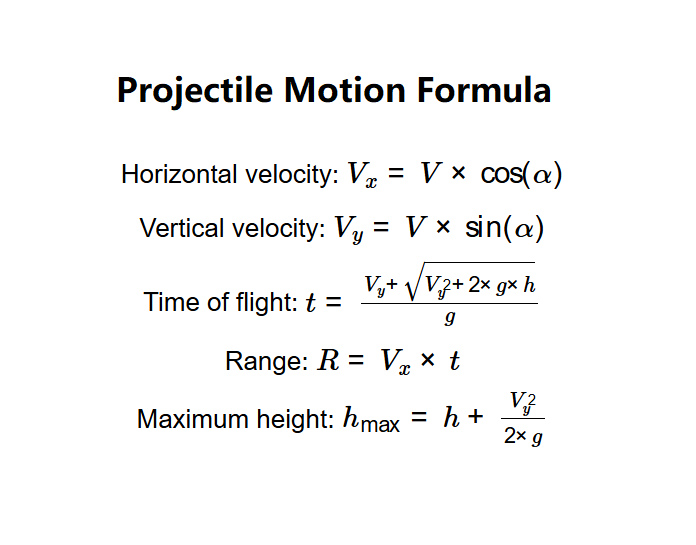1. What is the Projectile Motion Calculator?
Definition: This calculator computes the trajectory of a projectile launched with an initial velocity (\( V \)), angle (\( \alpha \)), and initial height (\( h \)), calculating the time of flight (\( t \)), range (\( R \)), and maximum height (\( h_{\text{max}} \)).
Purpose: It is used in physics to analyze the motion of objects under the influence of gravity, such as a ball thrown or a projectile fired.
2. How Does the Calculator Work?
The calculator uses the following equations:
- Horizontal velocity: \( V_x = V \times \cos(\alpha) \)
- Vertical velocity: \( V_y = V \times \sin(\alpha) \)
- Time of flight: \( t = \frac{V_y + \sqrt{V_y^2 + 2 \times g \times h}}{g} \)
- Range: \( R = V_x \times t \)
- Maximum height: \( h_{\text{max}} = h + \frac{V_y^2}{2 \times g} \)
Where:
- \( V \): Initial velocity (m/s, km/h, ft/s, mph);
- \( \alpha \): Angle of launch (degrees, radians);
- \( h \): Initial height (m, cm, ft, in);
- \( V_x \): Horizontal velocity component (m/s);
- \( V_y \): Vertical velocity component (m/s);
- \( t \): Time of flight (s, ms, min);
- \( R \): Range (m, km, cm, ft, in);
- \( h_{\text{max}} \): Maximum height (m, cm, ft, in);
- \( g \): Acceleration due to gravity (\( 9.81 \, \text{m/s}^2 \)).
Steps:
- Enter the initial velocity (\( V \)) with its unit.
- Enter the angle of launch (\( \alpha \)) with its unit.
- Enter the initial height (\( h \)) with its unit.
- Convert the inputs to base units (m/s for \( V \), radians for \( \alpha \), meters for \( h \)).
- Calculate the horizontal and vertical velocity components: \( V_x \) and \( V_y \).
- Calculate the time of flight: \( t = \frac{V_y + \sqrt{V_y^2 + 2 \times g \times h}}{g} \).
- Calculate the range: \( R = V_x \times t \).
- Calculate the maximum height: \( h_{\text{max}} = h + \frac{V_y^2}{2 \times g} \).
- Convert the results to the selected output units and display \( t \), \( R \), and \( h_{\text{max}} \), formatted in scientific notation if the absolute value is less than 0.001, otherwise with 4 decimal places.
3. Importance of Projectile Motion Calculation
Calculating projectile motion is crucial for:
- Physics Education: Understanding the principles of motion under gravity.
- Engineering: Designing trajectories for rockets, missiles, or sports equipment.
- Sports Science: Analyzing the motion of balls in sports like baseball or golf.
4. Using the Calculator
Example 1 (From Ground): Calculate the motion of a ball launched at 10 m/s, 45°, from the ground (\( h = 0 \)):
- Initial Velocity: \( V = 10 \, \text{m/s} \);
- Angle: \( \alpha = 45^\circ = \frac{\pi}{4} \, \text{radians} \);
- Initial Height: \( h = 0 \, \text{m} \);
- Horizontal Velocity: \( V_x = 10 \times \cos(\frac{\pi}{4}) \approx 7.071 \, \text{m/s} \);
- Vertical Velocity: \( V_y = 10 \times \sin(\frac{\pi}{4}) \approx 7.071 \, \text{m/s} \);
- Time of Flight: \( t = \frac{7.071 + \sqrt{7.071^2 + 0}}{9.81} \approx 1.442 \, \text{s} \);
- Range: \( R = 7.071 \times 1.442 \approx 10.198 \, \text{m} \);
- Maximum Height: \( h_{\text{max}} = 0 + \frac{7.071^2}{2 \times 9.81} \approx 2.550 \, \text{m} \);
- Result: \( t = 1.4420 \, \text{s} \), \( R = 10.1980 \, \text{m} \), \( h_{\text{max}} = 2.5500 \, \text{m} \).
Example 2 (From Elevation): Calculate the motion of a ball launched at 20 m/s, 30°, from a height of 5 m:
- Initial Velocity: \( V = 20 \, \text{m/s} \);
- Angle: \( \alpha = 30^\circ = \frac{\pi}{6} \, \text{radians} \);
- Initial Height: \( h = 5 \, \text{m} \);
- Horizontal Velocity: \( V_x = 20 \times \cos(\frac{\pi}{6}) \approx 17.321 \, \text{m/s} \);
- Vertical Velocity: \( V_y = 20 \times \sin(\frac{\pi}{6}) = 10 \, \text{m/s} \);
- Time of Flight: \( t = \frac{10 + \sqrt{10^2 + 2 \times 9.81 \times 5}}{9.81} \approx 2.347 \, \text{s} \);
- Range: \( R = 17.321 \times 2.347 \approx 40.662 \, \text{m} \);
- Maximum Height: \( h_{\text{max}} = 5 + \frac{10^2}{2 \times 9.81} \approx 10.102 \, \text{m} \);
- Result: \( t = 2.3470 \, \text{s} \), \( R = 40.6620 \, \text{m} \), \( h_{\text{max}} = 10.1020 \, \text{m} \).
5. Frequently Asked Questions (FAQ)
Q: What does projectile motion mean?
A: It refers to the motion of an object launched into the air, subject only to gravity and its initial velocity, following a parabolic trajectory.
Q: Why does the angle affect the range?
A: The angle determines the balance between horizontal and vertical velocity components. An angle of 45° typically maximizes range when launched from the ground.
Q: Does this calculator account for air resistance?
A: No, this calculator assumes a vacuum where only gravity affects the projectile. In reality, air resistance would reduce the range and height.
Projectile Motion Calculator© - All Rights Reserved 2025
 Home
Home
 Back
Back
